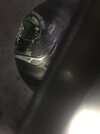You know, I understand what you guys are saying about and air leak, but aren’t there other reasons why the engine could rev out of control or idle high? Like a bad TPI? Or too much voltage going through the TPI making it think it wants to go higher? Or maybe a bad diode? What are the other reasons. If I find the crank seal is good how could it exhibit this behavior? I mean, if the engine is computer controlled, and there is an air leak, how does the computer know how to stay “in time” with the air leak? The whole thing is screwy. I did find those hoses and they all look fine. Of course I didn’t unplug them and blow them out or anything though.Download the manual here from this site.
http://www.seadooforum.com/manuals/2002_240FI.pdf
page 3C-8 shows the oil lines. Including the one that connects to the the top crankshaft bearing.
and page 4A-33 has a very nice picture of hose routing.
All this for your model of engine.
-
This site contains eBay affiliate links for which Sea-Doo Forum may be compensated.
Engine runs high idle/medium revs without lever action 2003 challenger X
- Thread starter Hawk111
- Start date





